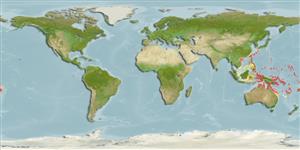>
Gobiiformes (Gobies) >
Gobiidae (Gobies) > Gobiinae
Etymology: Trimma: Greek, trimma, -atos = something crushed (Ref. 45335); capostriatum: Species name is presumably from the Latin 'caput' meaning head, end or point and 'striatus' meaning striped; referring the in referring to the alternating red and charcoal-blue stripes on the head (Ref. 100726).
Environment: milieu / climate zone / depth range / distribution range
Ekologi
laut berasosiasi dengan karang; kisaran kedalaman 1 - 22 m (Ref. 100726). Tropical
Southwest Pacific: Australia (GBR), New Caledonia, Vanuatu, the Solomons, the Bismark Archipelago, northern and southern New Guinea and Palau (Helen Reef).
Size / Weight / umur
Maturity: Lm ? range ? - ? cm
Max length : 2.9 cm SL jantan/; (Ref. 100726)
deskripsi pendek
Kunci identifiaksi (pengenalan) | Morfologi | Morfometrik
Duri punggung (Keseluruhan (total)) : 7; duri punggung lunak (Keseluruhan (total)) : 8 - 10; Duri dubur: 1; Sirip dubur lunak: 8. This species is distinguished by the following characters: presence of a deep trough in the bony interorbital region about half pupil-diameter in width; with a shallow trough behind the eye along the upper half of the posterodorsal margin of the eye; naked predorsal midline, sides of nape is scaled to just behind the eye; no scales on cheek and opercle; the pelvic fins is connected by a basal membrane reaching to the tips of fifth ray, forming an indented plate; central 4-11 pectoral rays are branched; 5-6 light stripes (orange to red in life) on head and with dark blue interspaces, the body light with distinct scattered oval or round spots (yellowish-orange, orange or reddish in life); the snout is mostly darkly pigmented without distinct stripes in preserved material, but with orange stripes in life; the upper lip largely dark, except posteriorly, usually with orange stripes from the eye obscured by dark pigment on the jaws; uniformly dark lower lip; lower surface of the head with a black curved stripe and with a median black bar connecting to the lower lip; branchiostegal membranes are predominantly light, except for the stripe and the inner margin of the membranes (Ref. 100726).
Common on middle and outer reefs (Ref. 100726).
Life cycle and mating behavior
Maturities | Reproduksi, perkembang biakan | Spawnings | Egg(s) | Fecundities | Larva
Winterbottom, R. and D.F. Hoese, 2015. A revision of the Australian species of Trimma (Actinopterygii, Gobiidae), with descriptions of six new species and redescriptions of twenty-three valid species. Zootaxa 3934(1):001-102. (Ref. 100726)
Status IUCN Red List (Ref. 130435)
ancaman kepada manusia
Harmless
penggunaan manusia
Alat, peralatan
laporan khas
muat turun XML
Sumber internet
Estimates based on models
Phylogenetic diversity index (Ref.
82804): PD
50 = 0.5000 [Uniqueness, from 0.5 = low to 2.0 = high].
Bayesian length-weight: a=0.00708 (0.00333 - 0.01504), b=3.09 (2.92 - 3.26), in cm total length, based on LWR estimates for this (Sub)family-body shape (Ref.
93245).
Daya lenting (Ref.
120179): Tinggi, Waktu penggandaan populasi minimum kurang dari 15 bulan (Preliminary K or Fecundity.).
Fishing Vulnerability (Ref.
59153): Low vulnerability (10 of 100).
